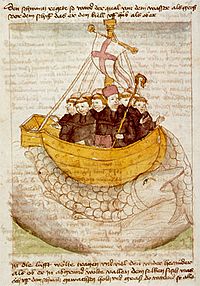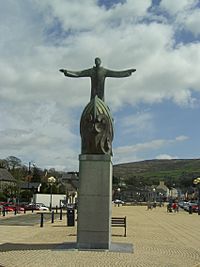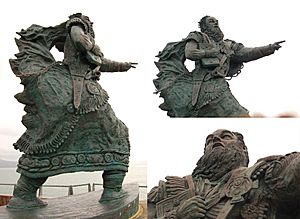Brendan facts for kids
Quick facts for kids SaintBrendan the Navigator |
|
|---|---|

"Saint Brendan and the Whale" from a 15th-century manuscript
|
|
| Catholic priest, abbot | |
| Born | c. AD 484 Ciarraighe Luachra near Tralee, Kingdom of Munster |
| Died | c. AD 577 Annaghdown, Kingdom of Connacht |
| Venerated in | Catholic Church Eastern Orthodox Church Anglican Communion |
| Major shrine | Clonfert, Ireland |
| Feast | 16 May |
| Attributes | whale; priest celebrating Mass on board a ship while fish gather to listen; one of a group of monks in a small boat |
| Patronage | boatmen; divers; mariners; sailors; travellers; whales; portaging canoes; Diocese of Clonfert; Diocese of Kerry |
Saint Brendan of Clonfert (born around 484 AD – died around 577 AD) was an early Irish monastic saint. He is also known as "Brendan the Navigator" or "Brendan the Voyager." He is famous for a legendary journey to a place called the "Isle of the Blessed," also known as Saint Brendan's Island. This amazing trip is described in an old story called the Navigatio Sancti Brendani Abbatis (which means "Voyage of Saint Brendan").
Saint Brendan is one of the Twelve Apostles of Ireland. His special day, called a feast day, is celebrated on May 16th by Catholics, Anglicans, and Orthodox Christians.
Contents
Early Life of Saint Brendan
Brendan was born in 484 AD in Tralee, located in County Kerry, in the southwest of Ireland. His parents were named Finnlug and Cara. People believe he was born near the Kilfenora/Fenit area.
He was baptized by Saint Erc of Slane and was first going to be named "Mobhí." However, special signs at his birth led to him being called 'Broen-finn,' meaning 'fair-drop.' For five years, he was taught by Saint Íte of Killeedy, a very respected teacher.
When he was six, Brendan went to Jarlath's monastery school in Tuam to continue his education. He is considered one of the "Twelve Apostles of Ireland," meaning he was taught by the famous teacher, Finnian of Clonard.
Brendan's Monasteries
When Brendan was 26, he became a priest. After that, he started many monasteries. His first trip took him to the Aran Islands, where he founded a monastery. He also visited an island off Scotland called Hinba, where he supposedly met Saint Columcille.
On the same journey, he traveled to Wales and then to Brittany in France. Between 512 AD and 530 AD, Brendan built monastic cells (small living spaces for monks) at Ardfert and Shanakeel, at the base of Mount Brandon. From Shanakeel, he is believed to have started his famous seven-year journey to find Paradise.
The Legendary Voyage
Brendan is most famous for his amazing journey to the Isle of the Blessed. This adventure is told in the Navigatio Sancti Brendani Abbatis (Voyage of Saint Brendan the Abbot), written in the 9th century. Many versions of this story exist.
The story says that Brendan set out on the Atlantic Ocean with sixteen monks. Some versions say there were fourteen monks and three people who joined at the last minute but didn't fully believe. They were searching for the Garden of Eden. One of his companions was said to be Saint Malo. This voyage is thought to have happened between 512 AD and 530 AD.
During his trip, Brendan supposedly saw Saint Brendan's Island, a beautiful island full of plants. He also met a sea monster, an adventure he shared with Saint Columcille. The most famous part of his journey is when he landed on an island that turned out to be a giant sea monster named "Jasconius."
The Story of the Voyage
The oldest written version of the Navigatio Sancti Brendani Abbatis was recorded around 900 AD. There are over 100 copies of this story across Europe and many translations. The Navigatio is a Christian story, but it also describes natural events and amazing, imaginary places. This made it popular with many different people.
On the coast of Kerry, Brendan built a special boat called a currach. It was made of wicker covered with animal hides that were treated with oak bark and butter. He added a mast and a sail. Brendan and his small group of monks fasted for 40 days. After a prayer on the shore, they began their journey in the name of the Most Holy Trinity.
The story uses a lot of imagination. For example, it talks about Hell where "great demons threw down lumps of fiery slag from an island with rivers of gold fire." It also mentions "great crystal pillars." Many people think these descriptions might be about volcanic activity around Iceland and icebergs.
Key Events in the Voyage
Here are some of the adventures Brendan and his monks had:
- A monk named Saint Barrid tells Brendan about a visit to the Island of Paradise, which inspires Brendan to search for it.
- Brendan gathers 14 monks to join him.
- They fast and visit Saint Enda.
- Three latecomers join the group, which causes problems.
- They find an island with a dog and mysterious food, but no people. They also see an Ethiopian devil.
- One of the latecomers admits to stealing, and Brendan helps him get rid of the devil. The latecomer then dies and is buried.
- They find an island where a boy shares bread and milk with them.
- They find an island of sheep, eat some, and stay for Holy Week before Easter.
- They discover the island of Jasconius (the giant whale), celebrate Easter Mass, and hunt whales and fish.
- They find the "Paradise of Birds," where birds sing religious songs and praise God.
- They find the island of the monks of Ailbe, who have special bread, don't age, and are completely silent. They celebrate Christmas there.
- After Lent, they have a long voyage. They find an island with a well, and drinking its water makes them sleep for one, two, or three days, depending on how much they drank.
- They find a "coagulated" (thickened) sea.
- They return to the islands of sheep, Jasconius, and the Paradise of Birds. A bird tells them they must continue this yearly journey for seven years to become holy enough to reach the Island of Paradise.
- A sea creature comes near their boat, but God protects them. Another sea creature attacks the first one, breaking it into three pieces. The monks eat the dead sea creature.
- They find an island with three groups of anchorites (monks living alone), who give them fruit. The second latecomer stays there.
- They find an island of grapes, where they stay for 40 days.
- They see a battle between a gryphon and a bird. The gryphon dies.
- They return to the monastery at Ailbe for Christmas again.
- The sea becomes clear, and many threatening fish swim around their boat, but God protects them.
- They find an island, but when they light a fire, the island sinks. They realize it was actually a whale.
- They pass a "silver pillar wrapped in a net" in the sea.
- They pass an island of blacksmiths, who throw hot slag at them.
- They find a volcano, and demons take the third latecomer down to Hell.
- They find Judas Iscariot sitting unhappily on a cold, wet rock in the sea. They learn this is his break from Hell on Sundays and feast days. Brendan protects Judas from demons for one night.
- They find an island where Paul the Hermit has lived a perfect monastic life for 60 years. He wears only hair and is fed by an otter.
- They return to the islands of sheep, Jasconius, and the Paradise of Birds.
- They finally find the Promised Land of the Saints.
- They return home, and Brendan dies.
The Navigatio is part of a popular type of Irish story called an immram. These stories were common in the 7th and 8th centuries. An immram usually describes a hero's sea adventures, sometimes searching for a magical island far to the west. The Navigatio is similar to older stories like The Voyage of Bran and the Voyage of Máel Dúin.
In the Navigatio, this style of storytelling mixes with the religious tradition of Irish monks traveling alone in boats, much like desert monks lived alone in caves. Brendan's voyages became one of the most famous European legends. Because many facts come from the Navigatio, it's hard for historians to tell what is real and what is folklore.
Did Brendan Reach North America?

While the story is often seen as a religious allegory (a story with a hidden meaning), people have wondered if the legends are based on real events. There has been much debate about where Saint Brendan's Island might be. Old maps showed it in many places, from south of Ireland to the Canary Islands, Faroes, or Azores.
Some people believe that the Irish were the first Europeans to reach the Americas. However, there is no strong proof that Brendan ever reached Greenland or the Americas. The Saint Brendan Society celebrates the idea that he was the first European to reach North America.
In 1978, Tim Severin showed that it is possible for a leather-covered boat, like the one described in the Navigatio, to reach North America. Severin's film, The Brendan Voyage, inspired the Irish composer Shaun Davey to write a musical piece with the same name.
The Navigatio was well-known in Europe during the Middle Ages. Maps from Christopher Columbus's time often included an island called Saint Brendan's Isle in the western Atlantic Ocean. Some historians believe Columbus might have learned from the Navigatio that ocean currents and winds would help him travel west by a southern route and return by a more northern route.
Later Life and Death
Brendan traveled to Wales and the holy island of Iona off the west coast of Scotland. When he returned to Ireland, he founded a monastery in Annaghdown, where he lived the rest of his life. He also started a convent (a place for nuns) in Annaghdown for his sister, Briga.
After setting up the bishopric (area led by a bishop) of Ardfert, Brendan went to Thomond and founded a monastery at Inis-da-druim (now Coney Island) around 550 AD. He then went back to Wales to study and later to Iona. He is said to have left his mark in places like Kil-brandon and Kil-brennan Sound in Scotland.
After three years in Britain, he returned to Ireland. He continued to spread Christianity in different parts of Leinster, especially at Dysart, County Kilkenny, and Killeney. He established churches at Inchiquin, County Galway, and Inishglora, County Mayo. He founded Clonfert in Galway around 557 AD.
Brendan died around 577 AD in Annaghdown while visiting his sister Briga. He had arranged for his body to be secretly taken back to the monastery he founded in Clonfert, hidden in a luggage cart. He was buried in Clonfert Cathedral.
Honoring Saint Brendan
Brendan is recognized as a saint by the Catholic Church. His feast day is celebrated on May 16th. As the story of his seven-year voyage spread, many pilgrims and students came to Ardfert. Religious houses were built in places like Gallerus, Kilmalchedor, Brandon Hill, and the Blasket Islands to help those seeking spiritual guidance from Brendan.
Brendan is the patron saint of sailors and travelers. At the United States Naval Academy in Annapolis, Maryland, a large stained glass window honors Brendan's achievements. In Fenit Harbour, Tralee, a large bronze sculpture by Tighe O'Donoghue/Ross was built to remember Brendan.
What Saint Brendan is Known For
Brendan the Navigator is the patron saint of two Irish dioceses: Kerry and Clonfert. He is also a patron saint for boatmen, sailors, travelers, older adventurers, and even whales. He is also known for helping with portaging canoes (carrying canoes over land).
Places Connected to Saint Brendan
Saint Brendan was very active in Western Ireland, where his most important monasteries are located. These include Ardfert (County Kerry), Inishdadroum (County Clare), Annaghdown (County Galway), and Clonfert (County Galway). His name lives on in many place names and landmarks along the Irish coast, such as Brandon Hill, Brandon Point, Mount Brandon, Brandon Well, Brandon Bay, and Brandon Head.
Brendan's most famous foundation was Clonfert Cathedral, which he established in 563 AD. He appointed Moinenn as its leader. Brendan was buried in Clonfert.
The old church buildings at Ardfert are very interesting. The ruins of the ancient Cathedral of St Brendan show different styles of Irish church architecture from the 7th or 8th century to later medieval Gothic styles.
List of Places Associated with Saint Brendan
|
|
Saint Brendan in Sicily
In the Sicilian town of Bronte, there is a church named after Saint Brendan, called "San Brandanu" in the local language. Since 1574, this "Chiesa di San Blandano" ("Church of Saint Brendan") replaced an older chapel. No one knows for sure why a church there was dedicated to Saint Brendan.
The Normans and other settlers brought the tradition of Saint Brendan to Sicily. There are very old papers from the 13th century in Sicily that mention him. In 1799, the area around Brontë became the British "Duchy of Horatio Nelson". The town of Drogheda in Ireland is twinned with Bronte.
Images for kids
See also
 In Spanish: Brendan para niños
In Spanish: Brendan para niños




